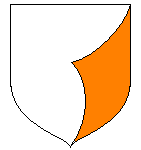Gore: Difference between revisions
No edit summary |
(links for image description) |
||
| (2 intermediate revisions by 2 users not shown) | |||
| Line 1: | Line 1: | ||
[[Image:gore.PNG|right|thumb|141px|[[Argent]] a '''gore''' [[sinister]] [[tenne]]]] |
|||
<div style="float:right; margin: 0 0 1em 1em;">[[Image:gore.PNG]]</div> |
|||
== Gore ([[heraldry]]) == |
|||
| ⚫ | In [[heraldry]], a '''gore''' is a [[charge]] which sometimes considered an [[ordinary]] and at other times a subordinary. It consists of two curved lines, one issuing from the [[dexter chief]], the [[base]], meeting in the centre of the shield. Traditionally the gore is considered an [[abatement]] indicating cowardice. |
||
| ⚫ | |||
| ⚫ | In [[heraldry]], a '''gore''' is a [[charge]] which sometimes considered an [[ordinary]] and at other times a subordinary. It consists of two |
||
| ⚫ | |||
[[Category:Device heraldry]] |
[[Category:Device heraldry]] |
||
== Gore ([[sewing]],[[ship]]s) == |
|||
A '''gore''' is a triangular piece of [[cloth]] which is used to add weight or volume to something. It is often associated with [[clothing]] like [[dress]]es or [[skirt]]s but also [[sail]]s. |
|||
=== Making gores for the Bottom Hem of A Tunic === |
|||
The easiest way to make gores is to take any rectangular scraps of fabric left over from the body of the [[tunic]] and cut them diagonally to make two triangles. Sew these triangles into the side seam of your [[t-tunic]] with the small end at the waist and the long end at the bottom [[hem]]. It's a bit tricky to get the top in neatly by machine - either handsew it, or just do the best job you can - the [[St Louis tunic]] is a very finely tailored [[14th century]] guys' [[shirt]] cut to a t-tunic design, and despite the rest being sewn nicely, there are apparently still wrinkles at the top of the gores. |
|||
[[category:sewing]] |
|||
Latest revision as of 11:54, 15 June 2006
Gore (heraldry)
In heraldry, a gore is a charge which sometimes considered an ordinary and at other times a subordinary. It consists of two curved lines, one issuing from the dexter chief, the base, meeting in the centre of the shield. Traditionally the gore is considered an abatement indicating cowardice.
Please note that the gore is not regarded within the SCA as being part of medieval heraldry. It was invented by English heraldic theorists in the late 16th century, but not used until long after the SCA's period (cf. http://www.s-gabriel.org/1202).
Gore (sewing,ships)
A gore is a triangular piece of cloth which is used to add weight or volume to something. It is often associated with clothing like dresses or skirts but also sails.
Making gores for the Bottom Hem of A Tunic
The easiest way to make gores is to take any rectangular scraps of fabric left over from the body of the tunic and cut them diagonally to make two triangles. Sew these triangles into the side seam of your t-tunic with the small end at the waist and the long end at the bottom hem. It's a bit tricky to get the top in neatly by machine - either handsew it, or just do the best job you can - the St Louis tunic is a very finely tailored 14th century guys' shirt cut to a t-tunic design, and despite the rest being sewn nicely, there are apparently still wrinkles at the top of the gores.
